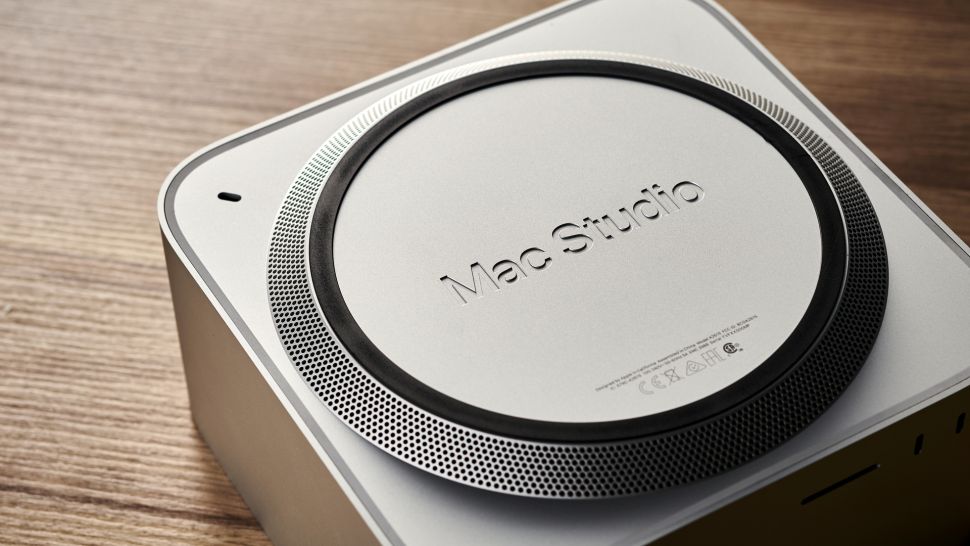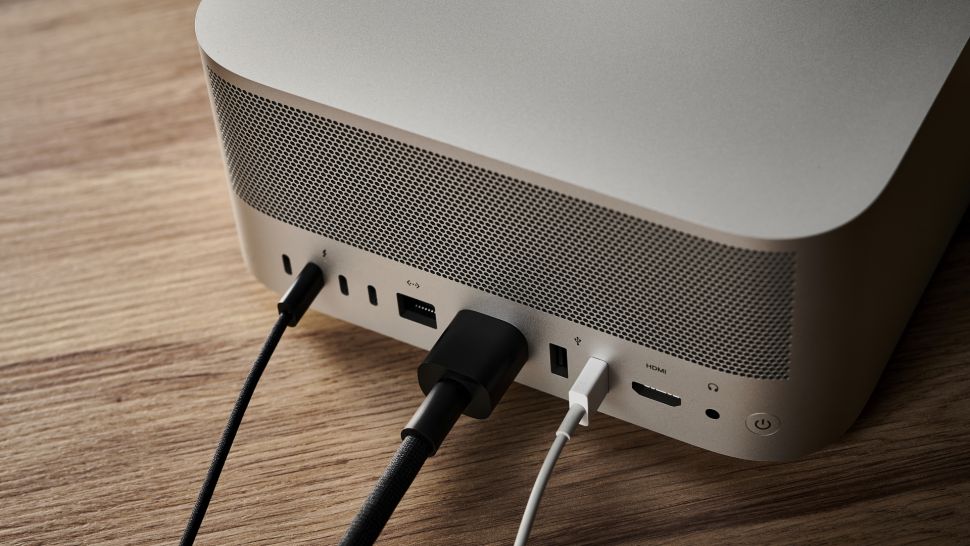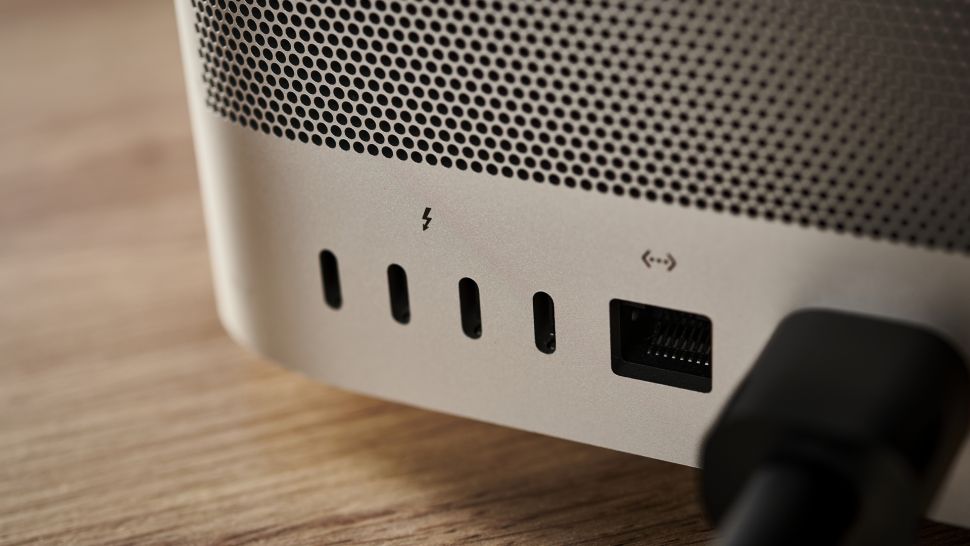Trade in Apple Mac Studio

(Image credit: Future)
Two-minute review
Here is the Mac Studio configuration sent to TechRadar for review:
CPU: Apple M1 Ultra (20-core)
Graphics: Integrated 64-core GPU
RAM: 128GB Unified SDRAM
Storage: 2TB PCIe SSD
Ports: 6x Thunderbolt 4 (USB-C), 2x USB-A, HDMI, 10Gb Ethernet, 3.5mm headphone jack, SDXC card slot
Connectivity: Wi-Fi 6, Bluetooth 5
Weight: 7.9 pounds (3.6kg)
Size: 3.7 x 7.7 x 7.7-inches (9.5 x 19.7 x 19.7 cm)
When Apple revealed the Mac Studio at its March Event, most folks were taken by surprise. There had been rumors about a new MacBook Air, and possibly a new M2 chip, but no one expected an entirely new Mac.
But that’s exactly what we got. After years of feeling like Apple lost interest in its Mac devices, preferring to lavish attention on its iPhones and iPads, the company seems to have fallen back in love with computers. Apple Macs are now some of the most exciting devices the company is currently producing, and the new Apple Studio Display is a welcome part of the family.
A huge part of this is the M1 chip. In 2020, Apple ditched Intel and released a MacBook Air, MacBook Pro and Mac mini all powered by its own M1 hardware. It was a huge success, offering excellent performance and power efficiency, and in late 2021, Apple expanded on the silicon with the M1 Pro and M1 Max chips, which offered drastically more performance, and launched alongside the MacBook Pro 14-inch (2021) and MacBook Pro 16-inch (2021).
The Mac Studio, being a desktop PC aimed at professional creatives, comes with a choice of the M1 Max or the brand-new M1 Ultra – which is essentially two M1 Max chips connected via a low-latency interface. This doubles the amount of unified memory, as well as the number of CPU and GPU cores, and in some cases offers almost twice the performance of the M1 Max.
The M1 Ultra-equipped Mac Studio, then, is for people who need a PC to hande heavy-duty workloads, such as rendering complex 3D scenes and animations or quickly compiling and testing code across numerous virtualized devices (to check how a game works on various generations of smartphones, for example). While not quite the most powerful Mac Apple has ever made, it’s certainly encroaching on the Mac Pro’s space.
We are Tradelectronics, licensed second-hand electronics dealer located in Sydney CBD, experts in trading used laptops, old cameras & lens, and used mobile phones. Fast, Reliable & We Pay More! Get a free quote on your favourite WhatsApp, Facebook, SMS & Email, instant reply!
| Click icon for WhatsApp Quote | Click icon for facebook Quote |
 |
 |
- We are open from Mon – Sat 12pm – 7pm
- Get your free quote from WhatsApp and Messenger are highly recommended, we can guide you through in finding the accurate specs for your laptops, cameras & lens, mobile phones as well. As such we can provide a more precise quote for you.

(Image credit: Future)
As we like to see with PCs for creative professionals, Apple has included a good selection of ports, including an all-important SD Card reader in the front.
In our tests, the Mac Studio performs beautifully, handling 8K video editing extremely well and utilizing advanced AI-powered photo editing tools in Adobe Photoshop. Even more impressive, it does all this quietly – a testament to the power efficiency of Apple’s M1 chips, as well as the thermal design of the Mac Studio.
If you’re a creative professional looking for a powerful and compact PC to work on, the Mac Studio is going to be a very tempting investment. Apple should be commended for what it’s achieved with this, but for mainstream users, you’re probably better off looking elsewhere.
Price and availability
The Mac Studio starts at a hefty $1,999 / £1,999 / AU$3,099 for the model with the M1 Max, certainly making it a pricey prospect.
Meanwhile, the Mac Studio with the new M1 Ultra chip, 64GB of unified memory and 1TB SSD will cost a huge $3,999 / £3,999 / AU$6,099. This could put a lot of people off.
If you want to go all-out, the maximum spec with the M1 Ultra, 128GB memory and 8TB SSD will cost you an eye-watering $7,999 / £7,999 / AU$12,099. That’s still cheaper than the most expensive Mac Pro, however.
Apple’s ageing Mac Pro workstation starts at $5,999 / £5,499 / AU$9,999, with configuration options that can add tens of thousands of dollars or pounds to the price. Compared to this, the Mac Studio looks a lot better value for people looking for a professional-grade creative workstation, especially considering the performance benefits the M1 Ultra brings.
The price of the Mac Studio also shows that this isn’t a device aimed at mainstream users. Instead, this is strictly for PC professionals, especially in the creative industries. For other people, the latest Mac mini (M1, 2020) is a much better proposition, and starts at $699 / £699 / AU$1,099.
However, if you need the power of the M1 Ultra chip, the Mac Studio is currently the only device that comes with it, and it’s available to pre-order right now, with deliveries starting March 18. However, we’re already seeing huge demand for the device, leading to longer wait times for delivery.

(Image credit: Future)
Design
If you’re a fan of the Mac mini, then you’ll like the design of the Mac Studio; it looks like a beefed-up version of its little brother. It’s built from a single aluminum extrusion, and has a square footprint of 7.7 inches and a height of 3.7 inches, making this an impressively compact computer considering the power on offer.
Compared to other workstation desktop PCs, the size of the Mac Studio is remarkable, and is even smaller than the Corsair One i300, one of our favorite compact PCs. This is due to the M1 Max or M1 Ultra chips that power the Mac Studio. Apple’s M1 SoC (system on a chip) includes the processor (CPU), graphics (GPU) and unified memory, among other things, in a single package that takes up less space than the separate components powering a traditional PC would.
We’ll go into what the M1 Ultra brings performance-wise in a bit, but the bottom line is that you’re just not going to get another PC of this performance level in such a compact chassis. For people who have a small amount of space to work on, or who like minimalist setups, the Mac Studio is going to really appeal.

(Image credit: Future)
While both the M1 Max and M1 Ultra Mac Studios have the same dimensions of 3.7 x 7.7 x 7.7-inches (9.5 x 19.7 x 19.7 cm), the M1 Ultra model is noticeably heavier, weighing 7.9 pounds (3.6kg) compared to the M1 Max model’s weight of 5.9 pounds (2.7kg). This is because the M1 Ultra needs a large copper thermal module, while the M1 Max, which runs cooler, uses a lighter aluminum heatsink. But even the heavier Mac Studio is perfectly easy to carry around and install wherever you like, especially compared to traditional desktop PCs.
All that power in such a small space does have heat implications, and to keep things cool, double-sided blowers channel airflow through the Mac Studio. Combine that with the power-efficient design of the M1 Max and M1 Ultra chips and you have a small PC that can handle intensive tasks without overheating. It’s certainly an impressive feat.
The Mac Studio also comes with a good range of connectivity options. There’s four Thunderbolt 4 ports, a 10Gb Ethernet port, two USB-A ports, an HDMI port and audio jack on the back, plus Wi-Fi 6 and Bluetooth 5.0.

(Image credit: Future)
An SD card slot on the front, along with two USB-C ports, round out the offering and should give most people plenty of scope for connecting their peripherals and devices; it’s good to see Apple continue to offer plenty of connectivity with its professional-grade hardware. If you have the M1 Ultra model, you can plug in four Pro Display XDR monitors and a 4K TV as well.
The front-facing ports make plugging stuff into them nice and easy if the Mac Studio is stashed away somewhere, but the power button is on the back, which can be a bit fiddly.
The power supply is also built into the Mac Studio, so there’s no ugly external power brick, which some compact PCs use to try to keep overall size down as much as possible.
If you watched Apple’s March Event, where it announced the Mac Studio alongside the Studio Display monitor, you’ll have likely heard the term ‘modular’ bandied about. Before you get too excited — Is the Mac Studio upgradable? Can multiple Mac Studios be daisy-chained together like Mac minis can into some uber-powerful super computer? — we have some bad news. By ‘modular’, Apple just meant that the Mac Studio doesn’t come with a display, or a keyboard or mouse. Yeah.
While buying a computer without a monitor is commonplace, some people will be peeved that the $3,999 / £3,999 / AU$6,099 doesn’t come with a keyboard and mouse. Apple will say this allows you to use the Mac Studio with the keyboard and mouse you already have and rely on, but if you don’t currently have those peripherals, you’ll need to factor in the price of extra peripherals. There’s no HDMI cable, either, so if you don’t have any of those to hand, you’re going to have a very expensive – though undeniably stylish – paperweight until you do.

(Image credit: Future)
Performance
When Apple announced the Mac Studio, it threw out some big claims, including that it’s 50% faster than the MacBook Pro 13-inch with M1 chip, and offers 3.4 faster graphics than the most powerful iMac.
It’s also apparently 80% faster than a Mac Pro with a 28-core Intel Xeon processor, and can support up to 18 streams of 8K ProRes video.
These boasts refer to the capabilities of the Mac Studio with the new M1 Ultra chip, which is the model we have for review, and likely to be the model most serious creatives are tempted by.
Before we get into the details of how the Mac Studio lives up to Apple’s claims, or if it falls short, we should give a shout out to the M1 Ultra, which really is remarkable. The M1 Ultra is essentially two M1 Max chips connected together using a super-fast and low latency connection known as UltraFusion.
When the M1 Max launched alongside the new MacBook Pro 14-inch and MacBook Pro 16-inch late last year as the most powerful chip Apple had ever designed, it actually featured the UltraFusion connection – which no one spotted.
This clever bit of forward thinking has allowed Apple to produce the M1 Ultra without altering the M1 Max. This means greater yields, as Apple doesn’t have to make new chips from scratch, which should avoid the sort of stock shortages we’ve seen with other chips recently.
With the Mac Studio aimed at creative professionals, and using the M1 Ultra comprised of two M1 Max chips, which have already shown how good they are for creative workloads in the new MacBooks, it’s perhaps little surprise to learn that the Mac Studio is a formidable machine when it comes to video editing, coding and 3D modeling, in particular.
When it comes to video, the Mac Studio puts in performance that easily rivals, and sometimes surpasses, desktop PCs with discrete professional graphics cards. This is impressive enough before you even factor in the compact size of the Mac Studio. It has the graphical grunt to handle 18 streams of 8K footage on the fly (which we tried for ourselves in Premiere Pro, allowing us to view, edit and add effects without having to wait for anything to render. The smoothness of the footage, even with numerous 8K elements on screen at once, is incredibly impressive – at one point the Mac Studio was putting through 8 billion pixels per second, and it coped admirably.

(Image credit: Future)
While 8K video editing, especially using multiple 8K sources, is probably more intensive than what a lot of people are going to need, it’s good to see just how far we can push the Mac Studio. This performance headroom also means this should be an excellent performer for years to come, and that future-proofness goes some way to justifying the price, and minimizes the issue of the Mac Studio not being upgradable.
Being able to edit such high-resolution footage on the fly, rather than having to wait for effects to load, or to render scenes before you preview, then re-render if you make any changes, also makes a big difference to your workflow. You will likely find yourself working much faster, and if you can complete projects earlier and take on more work, then the Mac Studio suddenly becomes a much more attractive investment.
Being able to work on and edit complex 3D scenes and models is also a game-changer, and the M1 Ultra-powered Mac Studio again handles things with aplomb. With our review model coming with 128GB of unified RAM, it means the M1 Ultra’s GPU can take advantage of this large amount of super-fast memory. With this, we saw the Mac Studio load up an incredibly detailed 3D scene that took up more memory than most discrete professional PC GPUs come with. For 3D animators and designers who really want to let their imaginations run wild without bumping up against hardware limits, the possibilities the Mac Studio – and certainly the M1 Ultra – are incredibly exciting.
Again, the ability to edit your scenes, move light sources or adjust cameras and textures and see your changes instantly is such an incredibly useful boost to your productivity that you may wonder how you ever coped without it.
The processing power of the M1 Ultra also deserves praise here. From quickly compiling and testing code, while also running multiple emulated instances to test your apps on a variety of devices, to using advanced AI and machine learning in Photoshop, the Mac Studio does an excellent job. In the latter’s case, this is thanks to the Neural Engine, which in the M1 Ultra features 32-cores. Apple claims that this allows it to run 22 trillion operations a second to help accelerate machine learning tasks. It’s also twice the amount of cores that come with the M1 Max.
Again, it’s best to see this in action. We used a variety of tools in Photoshop that rely in machine learning, and the results were very impressive. Quickly swapping out the sky for a more impressive cloud-filled look takes a matter of seconds. Doing these manually would take much longer, and it’s here that the extra power of the M1 Ultra is a real benefit.
This doesn’t mean the Mac Studio with M1 Max is not worth buying, however. While we don’t have one of those Mac Studio configurations, we’ve seen what the M1 Max can achieve in the latest MacBook Pro, and it’s still a fantastic chip, and still overkill for many. If you don’t need this kind of power for advanced professional uses, something more affordable, like the Mac mini, is a better choice. But, if you do need this power, the fact that Apple has made a PC the size of the Mac Studio so capable is very impressive indeed. It also remained incredibly quiet while we used it, even during intensive workloads.
Source: Techradar




